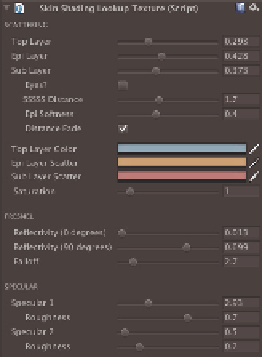Graphics Reference
In-Depth Information
Figure 1.2.
UI controls for multilayered skin and two specular lobes.
We use all four channels of pre-computed lookup texture separately to store
different information:
the first two channels contain
N
·
H
and
N
·
V
response for both specular
lobes;
the third channel contains a pre-computed Fresnel term for
N
·
V
;
the last channel contains an energy conservation term for the diffuse com-
ponent, the integral of light reflected before it enters subsurface layers.
Because of the use of pre-computed lookup texture, overhead for the second
specular lobe is negligible. Moreover, we achieve the energy conservation virtually
for free.
1.4.5 GPU Workload Balance
We strive to split the workload between pre-computing and real-time evaluation
of the parts of our lighting equation in such a way as to leverage the parallel
nature of GPU arithmetic units and texture access units.
Note that finding an appropriate size of the lookup texture is a very important
optimization step. An increase in the lookup texture size leads to better visual
quality with less visible banding, but at the same time puts more stress on the
texture cache and causes potential micro-stalls. For our demo we chose to use a
32
×
128 resolution for the lookup texture.









